Components Placement
Component placement should follow the signal path of the schematic and also provide space for the trace routing.
In addition to this, the following rules should be followed:
- Power supply parts should be placed compactly and properly decoupled to achieve power integrity.
- Decoupling capacitors should be placed as close as possible to the individual components.
- Connectors should be placed at the edge of the board
- Follow the schematic flow for high frequency components
- Memory components and processors (e.g., clock generators and controllers ) should be placed in the center of the PCB board.
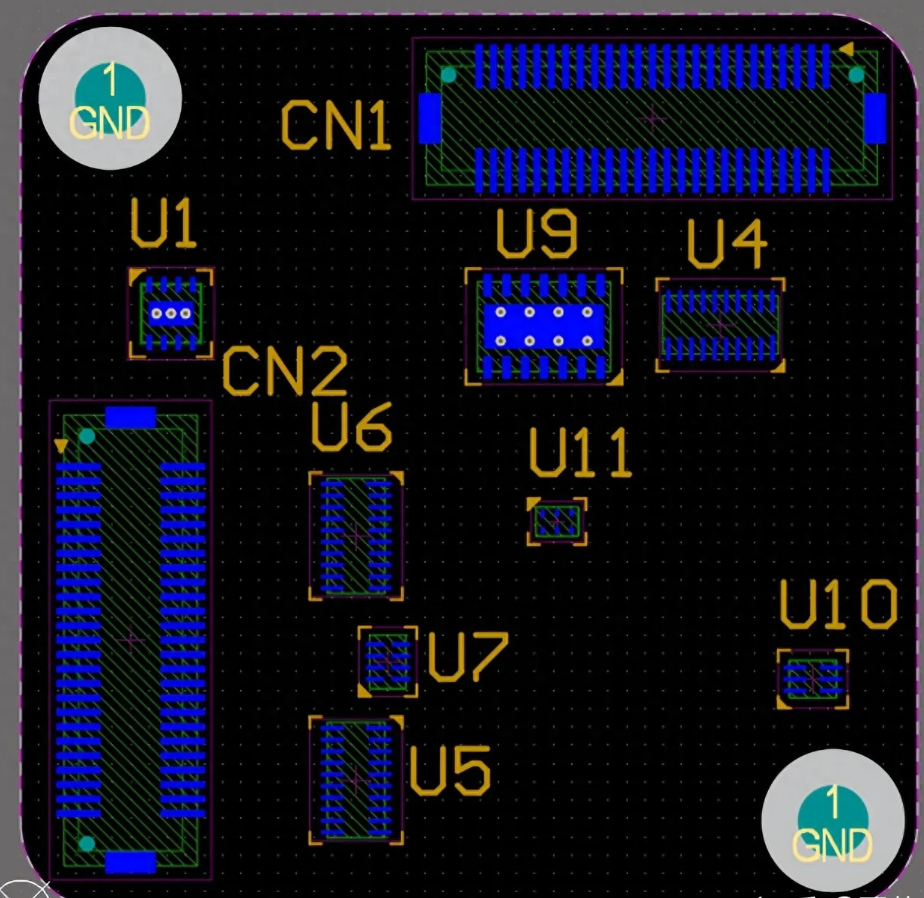
Digital and analog modules to be separated
To minimize the common return path of analog and digital signals, separate analog and digital modules to prevent mixing analog and digital signals.
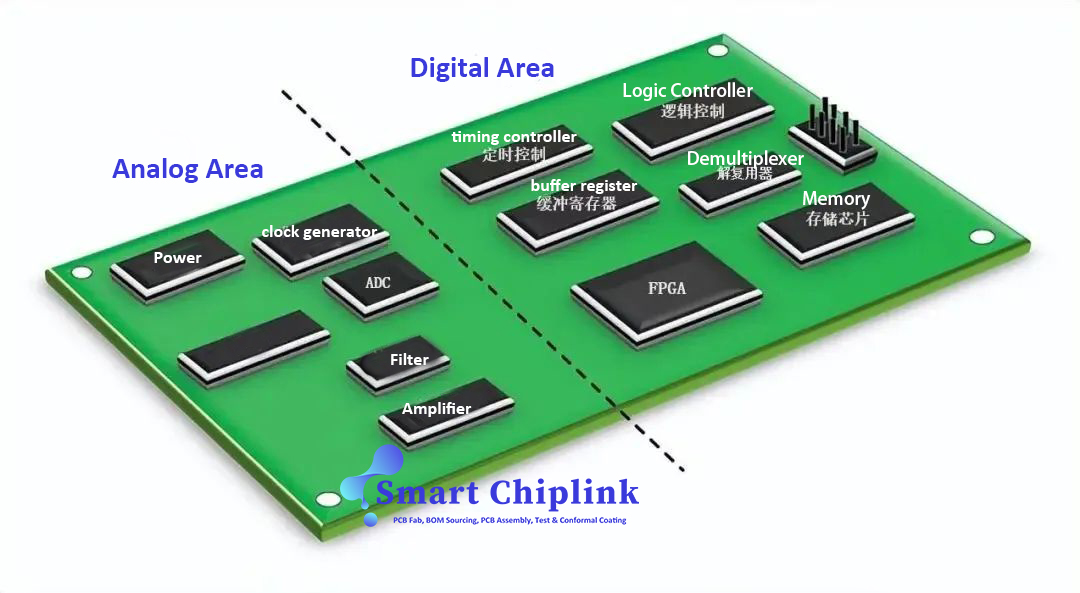
The figure above shows an example of separating analog and digital circuits.
The following points should be kept in mind when dividing the analog and digital sections:
- It is recommended to install analog components (such as amplifiers and reference voltage sources) in the analog circuit area. On the other side the digital circuit area, must be used with components related to digital circuits, such as logic controllers and timers.
- Analog-to-digital converters (ADC) or digital-to-analog converters (DAC) in a system are mixed signals and have low digital currents, which are handled similarly to how analog components are handled in an analog system.
- For designs with a large number of high-current ADC components and DAC components, it is recommended that the analog power supply be separated from the digital power supply. In other words, the DVDD should be connected to the digital section, and the AVCC must be connected to the analog section.
- The space and heat generated by microprocessors and microcontrollers can be significant. To improve heat dissipation, these components must be placed in the center of the board and must be close to the circuit blocks they are to be connected to.
PCB Trace Routing
With all components correctly placed in the optimum location and proper ground planes established, most routes will naturally follow the correct path. However, the following guidelines should be kept in mind when tracing routes:
- Signal paths should be as direct and short as possible
- Layers with high-speed signal paths should have a ground plane adjacent to them to ensure proper return signals
- High-speed circuits are particularly sensitive and need to follow the signal paths laid out in the schematics
- Reduce inductance in power supply wiring by using short, direct, and wide alignments.
- Do not create antennas when routing alignments and vias.
- Power supply wiring should be short, compact, and should have a wide trace.
- Cabling needs to maintain isolation between digital and analog circuit components.
- Grounding is important, especially for alignments connecting digital and analog partition areas.
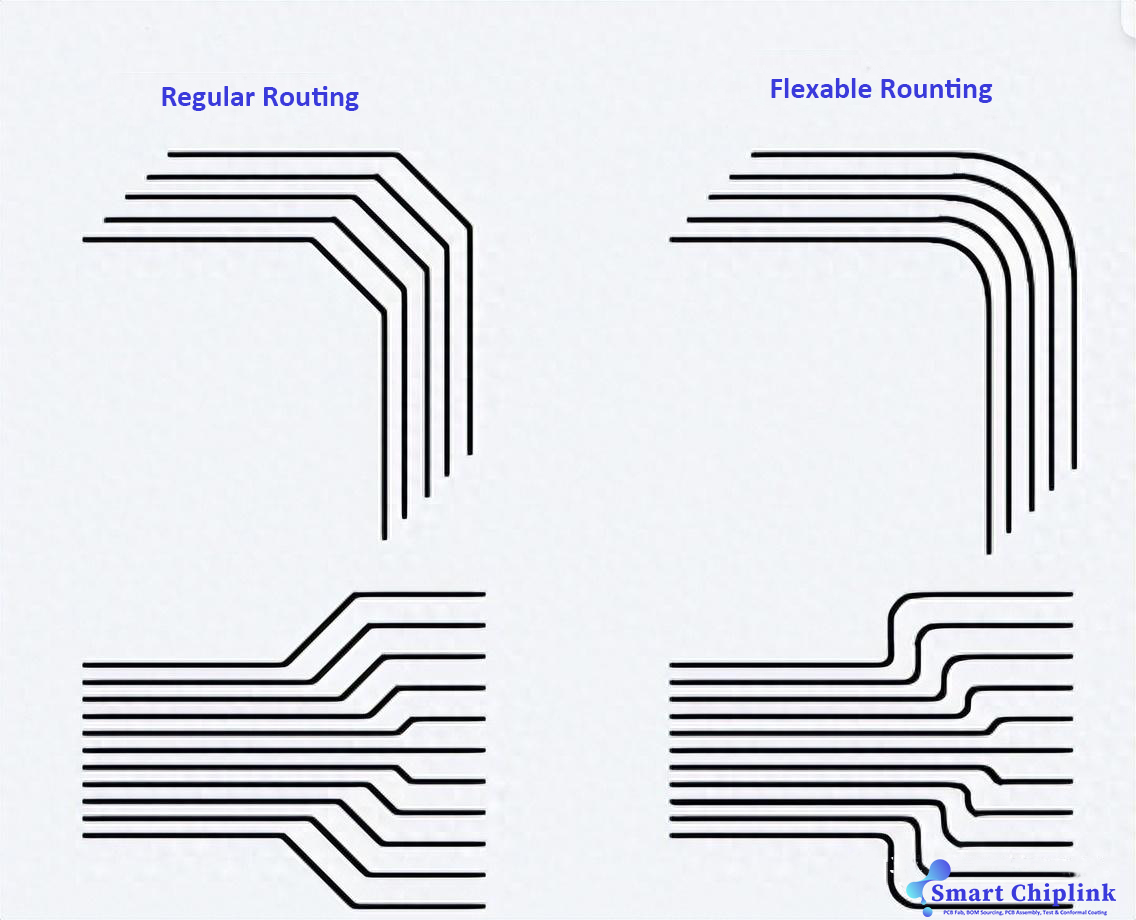
Power Supply Modules
The power supply is an important part of the circuit and needs to be handled with care.
Generally, power supply modules must be located close to the components that power them, while being isolated from the rest of the circuit.
When devices in complex systems have many power pins, dedicated power supply modules can be used for both analog and digital sections to prevent noisy digital interference.
To minimize inductance and prevent current limiting, power cables should be short and straight and use wide alignments.
Decoupling
One of the key factors that engineers must consider in order to meet the required performance of a system is the Power Supply Rejection Ratio (PSRR).
The performance of a device is ultimately determined by the PSRR, which evaluates the device's sensitivity to power supply variations.
In order to maintain an ideal PSRR, high-frequency energy needs to be prevented from entering the device.
To do this, a combination of electrolytic and ceramic capacitors is used to effectively isolate the device power supply from high impedance ground layers.
Effective decoupling is about having a low noise environment when the circuit is in operation. The basic rule is to provide the shortest possible path for the current to return more easily.
Below are some general decoupling methods:
- Low inductance ceramic capacitors are used to reduce high frequency noise, while electrolytic capacitors reduce low frequency noise on the power supply by acting as a charge reservoir for transient currents.
- Additionally, ferrite beads are optional but can enhance isolation and decoupling of high frequency noise.
- Decoupling capacitors need to be placed as close as possible to the power supply pins of the device. To minimize additional series inductance, these capacitors should be connected to a large portion of the low-impedance ground layer using an over-hole or short length of wire.
- The power supply pins of the device should be placed as close to the device as possible. Smaller capacitors (typically 0.01F to 0.1F) should be used; This configuration avoids the device operating in an unstable manner when multiple outputs are switched simultaneously. Electrolytic capacitors should not be more than an inch away from the device power pins (10F to 100F on average).
- A decoupling capacitor can be T-connected to the ground plane using an over-hole close to the device GND pin to simplify the construction rather than building an alignment.
You can see the diagram below for details:

PCB Stacking
Consider the PCB stacking before PCB routing, otherwise it will affect the return path allowed by the system design.
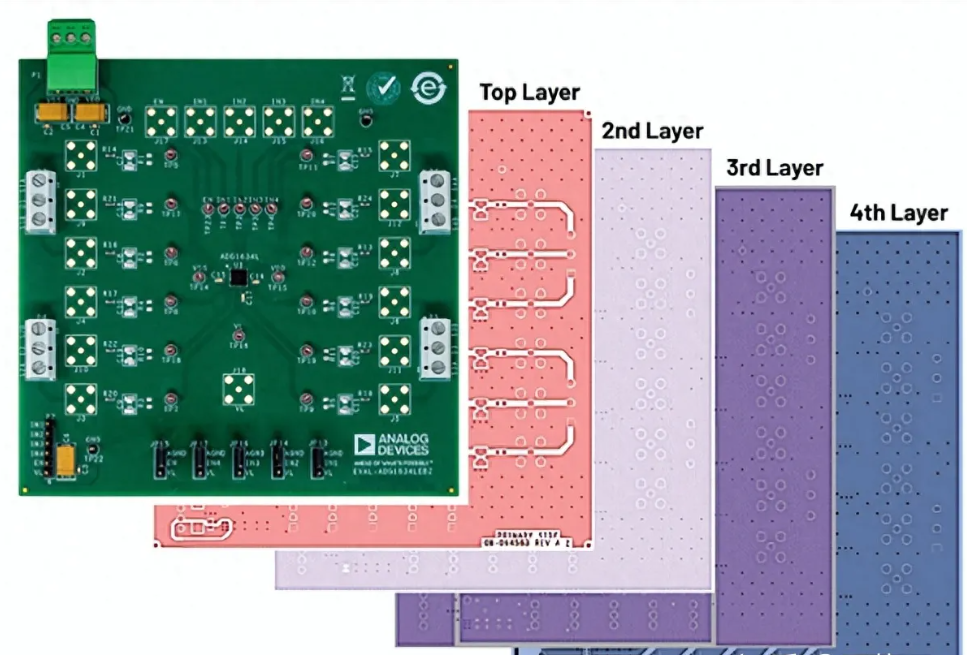
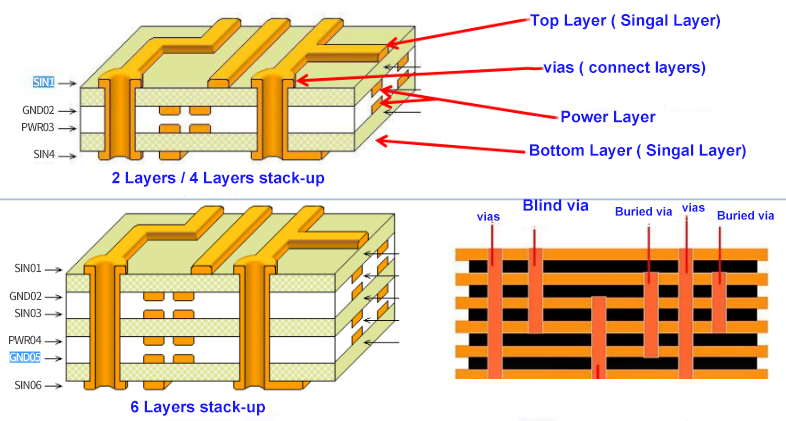
High-performance data collection systems should typically contain 4 or more layers.
Auxiliary signals are typically used in the bottom layer, while digital and analog signals are typically used in the top layer. The second layer (also known as the grounding layer) reduces the IR drop and protects the digital signals in the top layer by acting as a reference layer for impedance control signals. The power supply layers are located in the third layer.
Because they provide additional inter layer capacitance, the power and ground layers must be close to each other in order for the power supply to decouple at high frequencies.
PCB Copper Resistors
Copper resistance is also important in mixed-signal PCB layout. The routing of copper creates a good interconnect and grounding layer.
Most PCBs use 1 oz copper, but high power sections may use 2 or 3 oz copper.
At 25°C, copper has a resistivity of 1.724X10 -6 Ω/cm.
1 oz copper foil is normally 0.036 mm (0.0014 in) thick and has a resistance of 0.48 mΩ/square. For example, 0.25 mm (10 mil) wide trace routing on PCB has a resistance/length of about 19 mΩ/cm (48 mΩin).
PCB trace resistance can be a source of error in mixed-signal ICs.
For a 16-bit ADC with 5 kΩ input resistance, driven through a 5 cm 0.25 mm wide 1 oz copper drive, the track resistance is 0.1 Ω and forms a voltage divider with a 5 kΩ load, yielding an error/5 k of 0.1 (~0.0019%), which is higher than the 16-bit's 1 LSB (0.0015%), as shown below:

In practice this may be even worse as it ignores the return path and the 0.4%/°C temperature coefficient of copper at 25°C. When dealing with low impedance precision circuits, copper resistance is critical to a successful design.
Grounding
01 single grounding layer
The best way is to use a single solid ground plane for mixed-signal systems with a single low digital current ADC or DAC.
To understand the importance of a single ground plane, the return current needs to be analyzed here.
The term "return current" describes the current that completes the circuit loop and flows back to ground. Each return path must be followed throughout the PCB layout to avoid mixed signal interference.
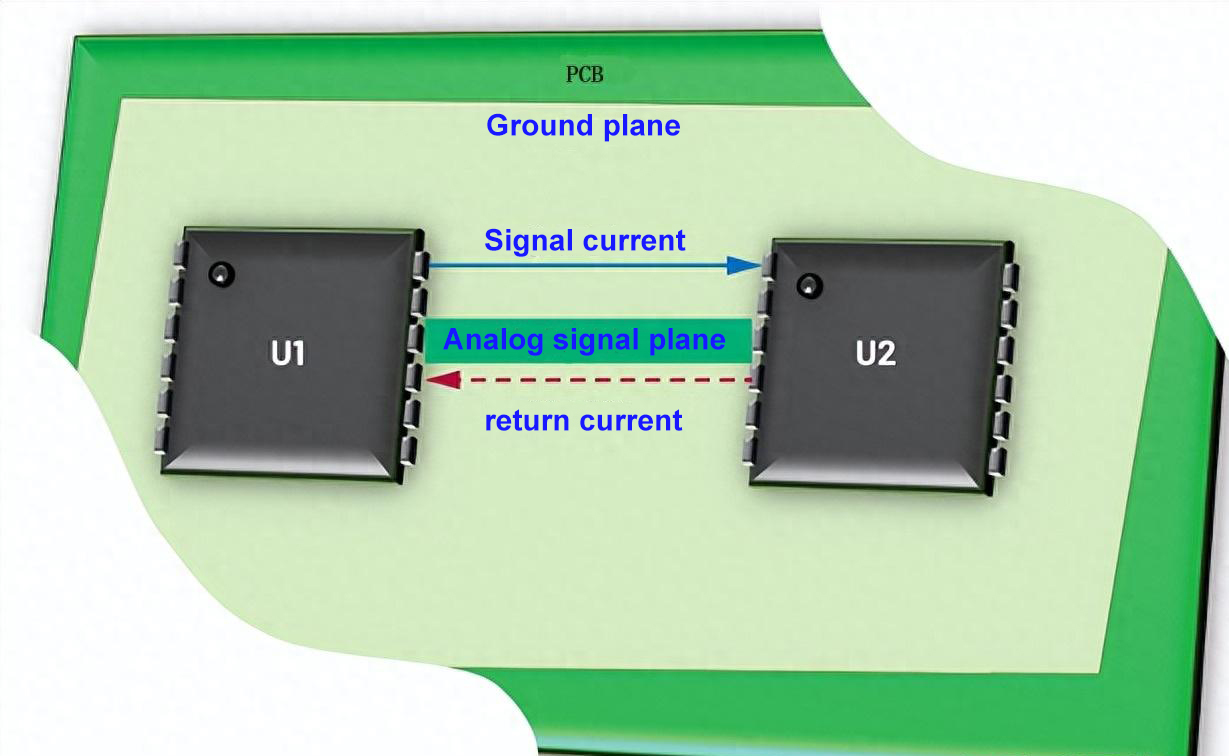
The simple circuit shown above illustrates the advantages of a single solid grounding layer over multiple grounding layers.
A return current exists that is equal but opposite to the signal current. When the return current returns to a source in the grounding layer, that return current will take the path of least resistance.
The path of least resistance (usually a straight line between the device ground references) will follow the low frequency transmission of the return current. However, a portion of the return current will attempt to return along the signal channel for higher frequency transmission. This is due to the lower impedance and smaller loop created between the output and return currents along that channel.
02 Independent AGND and DGND
Another typical strategy is to divide the ground plane into two halves :
Analog ground plane and Digital ground plane.
This is suitable for more complex systems with a large number of mixed-signal components and high digital current requirements.
The following diagram shows an illustration of a system with a divided ground plane :
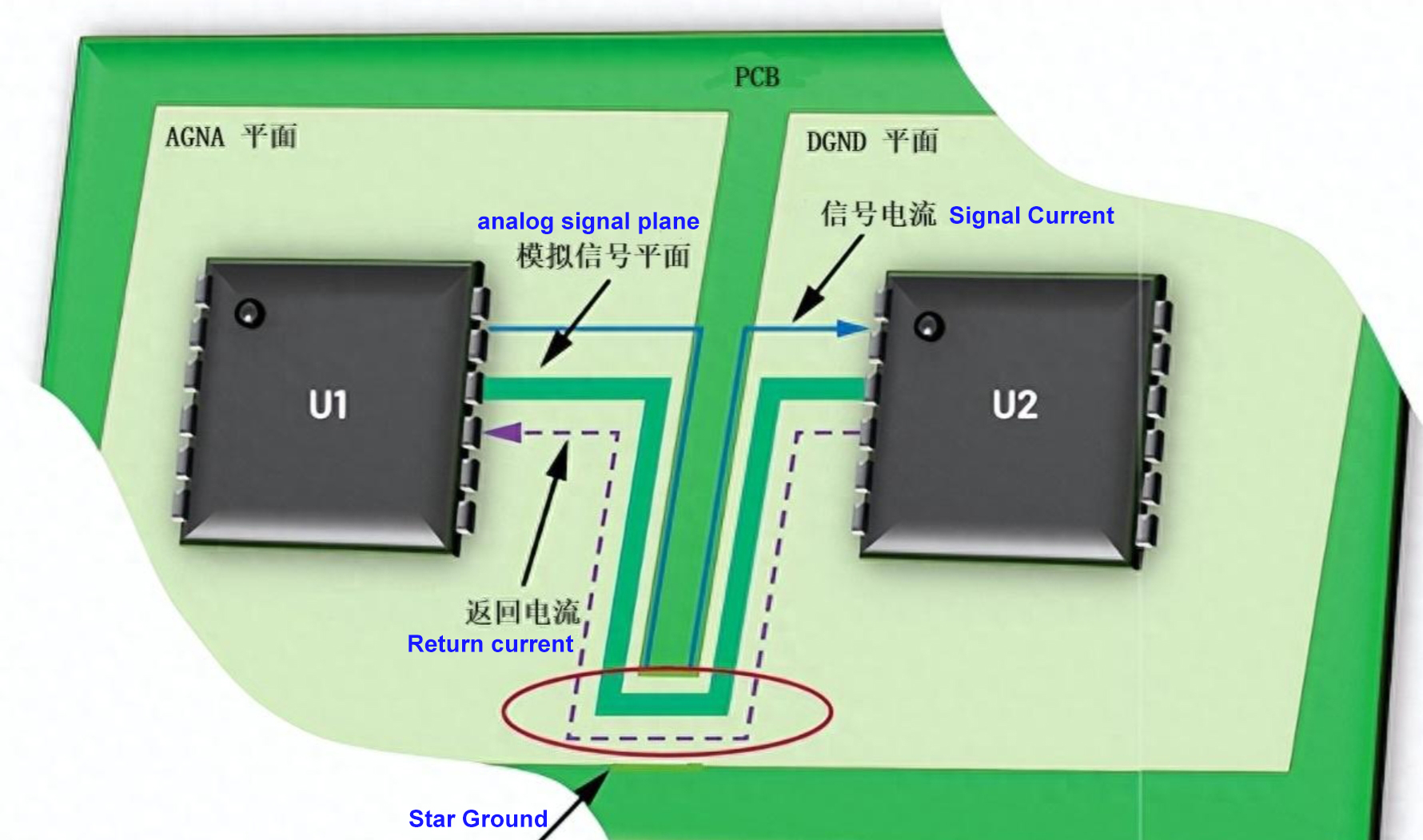
Return current for systems using separate grounding layers.
Eliminating the grounding layer break and allowing the return current to take a more direct path and flow back through the star ground junction is the simplest way to achieve an integral ground for systems with separate grounding layers.
In a mixed-signal layout, the intersection of the analog and digital ground layers is called a star ground.
The star ground can be connected to the typical thin continuous connection between analog and digital ground layers found in common systems. For more complex systems, star grounding is often performed by shunting a jumper to the ground connection.
Since star grounding has no current, high current carrying connectors and jumper shunts are not required. The main function of star grounding is to ensure that both grounds have the same reference level.
On the other hand, since the star ground also connects two grounds in one location, mixed-signal devices with AGND and DGND pins can be connected to their respective ground layers. This separates the delicate analog circuitry from the noisy digital currents that pass through the digital power supply all the way to the digital ground layer and then back to the digital power supply.
Multi-layer PCBs must have complete isolation of the AGND and DGND planes.
Electromagnetic Interference Shielding
After ground bounce, crosstalk, power supply noise, and other disturbances are resolved, circuits throw may suffer from electromagnetic interference or EMI. this can cause a variety of problems, for example:
- Interference with wireless communications
- Interruption of communication
- Corruption of sensor data
- Component failures
- Software errors and failures
One effective way to deal with EMI is to use a sufficient amount of metal shielding. Preferably, the shielding should form a Faraday cage that covers the circuit from all six sides and the ground plane.
While the use of shielding will stop most incoming EMI, thermal cooling issues must be addressed and signal inputs and outputs must be allowed.

 English
English Español
Español Português
Português русский
русский français
français 日本語
日本語 Deutsch
Deutsch Tiếng Việt
Tiếng Việt Italiano
Italiano Nederlands
Nederlands ไทย
ไทย Polski
Polski 한국어
한국어 Svenska
Svenska magyar
magyar Malay
Malay বাংলা
বাংলা Dansk
Dansk Suomi
Suomi हिन्दी
हिन्दी Pilipino
Pilipino Türk
Türk Gaeilge
Gaeilge عربى
عربى Indonesia
Indonesia norsk
norsk čeština
čeština Ελληνικά
Ελληνικά Українська
Українська Javanese
Javanese فارسی
فارسی български
български ລາວ
ລາວ Latine
Latine Қазақ
Қазақ Euskal
Euskal Azərbaycan
Azərbaycan slovenský
slovenský Македонски
Македонски Lietuvos
Lietuvos Eesti Keel
Eesti Keel Română
Română Slovenski
Slovenski Српски
Српски 简体中文
简体中文 Беларус
Беларус













